You may be familiar with concrete or stone retaining walls.
But, what about wood?
Using wood or timber as a retaining wall may be daunting for some, because we all know that moisture will be much of an issue here.
However, in the right setting, a wood retaining wall can blend into a landscape more naturally than concrete or even stone material.
- Combination of Raw Concrete and Raw Wood Retaining Wall
- Using Redwood as a Top of a Low Retaining Wall Idea in a Deck
- Juniper Wood Retaining Wall Idea in a Mid-century Backyard
- Horizontal Slab of Woods as a Retaining Wall in a Contemporary Landscape
- Pressure Treated Wood Retaining Wall on a Sloped Area
- Sealed Redwood Retaining Wall Completed with LED Lights
- Wood Lattice Panel Paired with Retaining Wall in a Hillside Landscape
- Dark Tone Wood Retaining Wall to Create a Modern Landscape
- 1×4 Stained Cedar Structural Retaining Wall to Create a Flat Space on a Hillside Garden
- Concrete and Wood Retaining Wall Completed with Water Feature
- Wood Retaining Wall Achieved with a Top and a Water Fountain
- Unfinished Wood Retaining Wall with Asymmetrical Ends
- Rustic Landscape with Wood Retaining Wall and Decorative Items
- Light Tone Wood Retaining Wall Completed with Stairs and Decks
The wood retaining wall is particularly pretty in the woodland garden or rustic landscape, composed of majestic trees.
If you still feel uncertain about installing a wood retaining wall, you should also know that in most cases, it only needs a low cost and simple construction to install a wood retaining wall in your landscape.
It is the most common option for a DIY project of a home improvement.
If you still decide to hire a contractor, know that a wood retaining wall is also a cheap way for your contractor to control short slopes that prove unstable and may erode after a while.
A wood retaining wall is commonly less than four feet tall.
There are two fundamental construction methods; each one fits different conditions.
One uses upright stanchions tied up in a concrete footing with 2×6 horizontal wall planks. This is commonly used for raised beds in the garden.
The second method is constructed particularly for large timbers, commonly 6c6, reinforced and stacked by steel rods pushed through the drilled holes.
So, what is the best method for you? Your contractor will choose the best construction method for your landscape.
When it comes to the wood species, you can see from the pictures below that most homeowners prefer to use redwood, cedar, Douglas fir, and juniper. Those are the popular wood types used for the wall.
Now, let’s take a look at the pictures of these 14 majestic wood retaining wall ideas that you can use if you don’t want to settle for a usual landscape:
1. Combination of Raw Concrete and Raw Wood Retaining Wall

This landscape doesn’t only use wood as its main material of retaining walls. The constructor decided it would be best if the wood retaining wall was combined with concrete. These walls are raw wood and raw concrete placed side by side.
The concrete is natural with no treatment whatsoever, maybe some soil staining. The wood is raw landscape timber in a medium tone.
You can see that the wood retaining wall is completed with the top made of similar wood. The top is used as a space to put some potted plants.
Using concrete and wood retaining walls like this is perfect for a contemporary landscape.
The concrete wall is higher than the wood wall. The height difference delivers an even more contrast look to these two different materials.
2. Using Redwood as a Top of a Low Retaining Wall Idea in a Deck
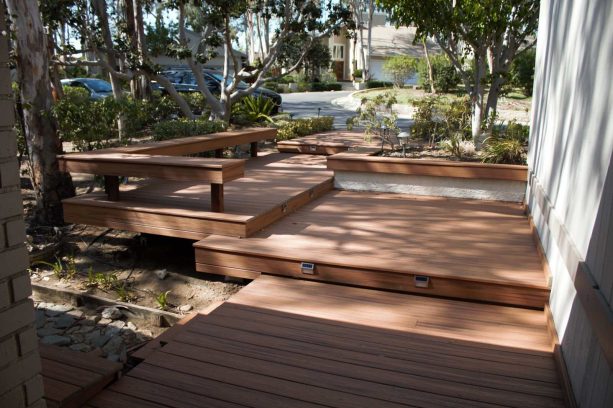
This is an ideal example of a large backyard in contemporary style completed with a deck, perfect for a hanging-out space during the summer.
The deck is completed with a bench, but, the most striking part is the big planter box that is retained by a wall.
The low wall seems to be made of cemented bricks. The top of the low wall is completed with wood that is similar to the deck around. The wood itself is Redwood, finished with a grey stain.
Using the same wood species for the whole elements in this backyard creates a flowing and consistent look. Thus, the yard appears more polished and stylish.
The low white wall accentuates the all-wood design, making a perfect contemporary landscape.
3. Juniper Wood Retaining Wall Idea in a Mid-century Backyard
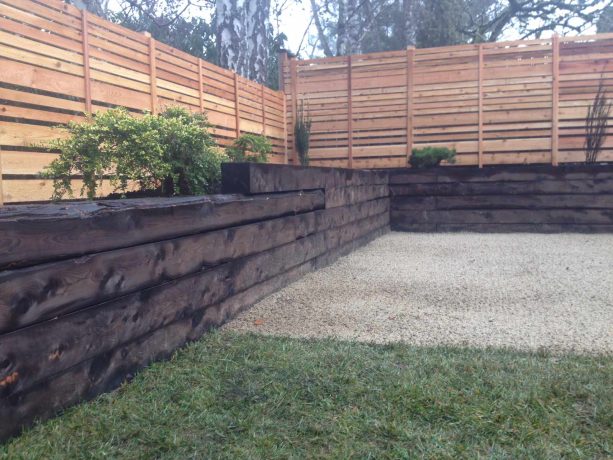
If you want a darker tone wood retaining wall, you can use juniper wood like this.
This is a juniper wood retaining wall finished with shou-sugi-ban.
This mid-century modern backyard is also completed with a wooden fence at the top as a boundary to separate this backyard from other areas in the property.
The wood retaining wall and the wood fence have two different tones; one is dark while the other is light. The contrast delivers a nice look in this minimalist yard.
Even though it is minimalist with less decorative items and plants, with a bold contrast like this, the yard appears more stylish.
There is a different level of the retaining wall. It is another way to create a trendy look in modern landscaping.
4. Horizontal Slab of Woods as a Retaining Wall in a Contemporary Landscape
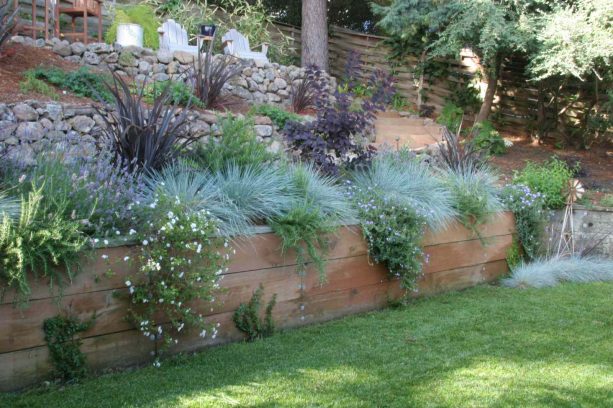
This multiple-level sloped landscape has two retaining walls, one is made of stone, and the other is made of wood.
The upper level features a stone wall, which is also used as a patio.
In order to reach the patio, there is a concrete stair surrounded by plants on both sides.
The lowest level is retained by a wood wall. These horizontal slabs of woods don’t seem too high, but it is enough to keep the soil in its place.
The ground that it is retained is planted with bushes, green foliages, and some creepers to decorate and accentuate the wood wall.
5. Pressure Treated Wood Retaining Wall on a Sloped Area
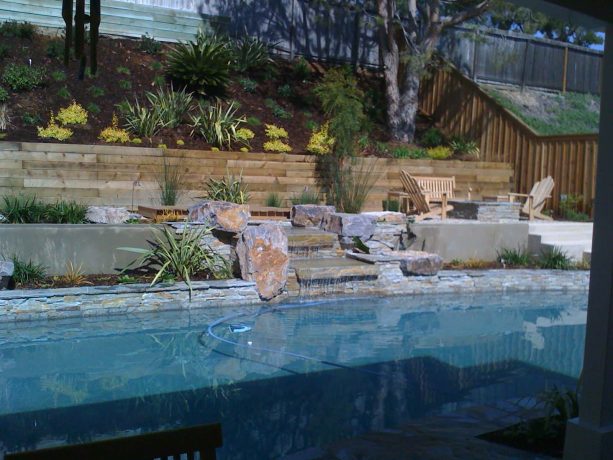
A sloped area like this is usually retained by a concrete wall. However, the contractor and the homeowner decided to use wood instead to create an unusual feel.
In order to retain that much soil, the retaining wall should be quite high.
The bushes, foliages, and trees were planted there to help absorb the rainwater. So, when the rain falls, it won’t pool and make the retaining wood rot.
These horizontal wood planks are basically pressure-treated wood, which is the best option you can use as a retaining wall for it can handle moisture very well.
6. Sealed Redwood Retaining Wall Completed with LED Lights

This is another combination of wood and concrete. However, unlike the previous picture where the wood and the concrete are similarly used as a retaining wall built side by side, these materials are used for a totally different reason.
The concrete is for the flooring, while the wood is for the retaining wall. But, both are installed side by side, creating a modern polished look.
The wood is redwood finished with a wood sealer in order to achieve a sleek look like this. The concrete is finished in dark gray, even though it’s somewhat faded in this picture.
What makes the wood retaining wall different is it is completed with LED lights. So in the evening, this patio appears bright and well-lit.
7. Wood Lattice Panel Paired with Retaining Wall in a Hillside Landscape

This multiple-level landscape features a wood retaining wall on every level. However, in the lowest part, the wall is accentuated with a wood lattice panel.
Why use latticework like this?
You can see that this landscape looks a bit too plain. There is just too much soil with minimal plants. So the whole yard looks brown instead of green.
Moreover, the medium tone wood retaining walls around are also similarly brown. It may appear boring for some. The latticework is added to accentuate the whole look. So even though it is all brown, there is an eye-catching decorative item here.
The hillside landscape looks sloppy, so it needs multiple levels to keep the soil in its place securely.
The latticework also works as a boundary to frame the grass area at the low level of this landscape.
8. Dark Tone Wood Retaining Wall to Create a Modern Landscape
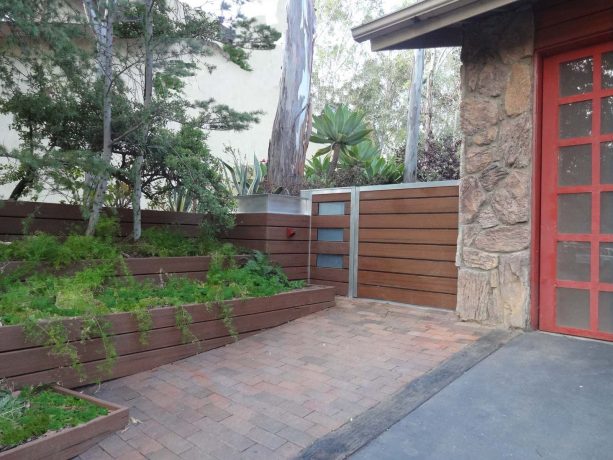
Basically, this landscape was created to achieve a modern design with a touch of a zen vibe.
Unlike the previous pictures, this front yard is not located on a hillside with a slope. However, the retaining walls were added to create a multiple-level look in this basically a flat area.
The horizontal slab of woods is in a dark tone, which is similar to the gate.
Using a similar material for the gate and the retaining walls makes it as if the walls were the extension of the gate.
The retaining walls are used to border the areas, which are utilized as a huge planter box.
Instead of colorful perennials, the homeowners use creepers, bushes, and even trees in these areas to create a modern yet natural look.
9. 1×4 Stained Cedar Structural Retaining Wall to Create a Flat Space on a Hillside Garden
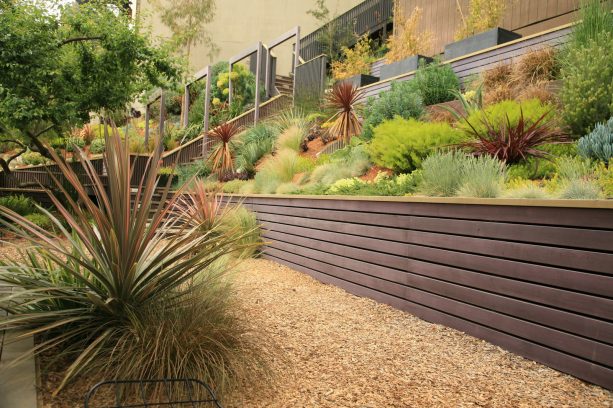
Even though the hillside is quite slopy, the contractor decided to create a single level instead of multiple for this landscape. This way, it needs a high retaining wall to retain soil that much.
However, there is a flat area at the upper part that is used as a planter boxes spot.
Basically, this modern landscape looks stylish. It features a structural retaining wall to achieve a flat space on a hillside garden.
The wall is 1×4 stained cedar that is also completed with a top. The cedar wood is cut into a horizontal slab stacked together. Its dark tone gives a nice contrast appearance to the natural garden around.
10. Concrete and Wood Retaining Wall Completed with Water Feature
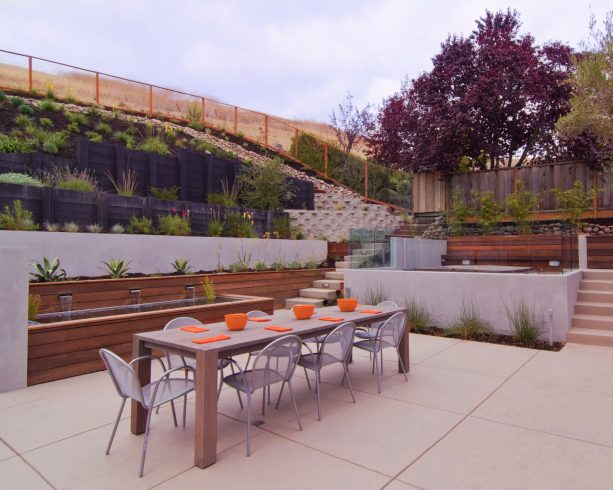
What a sleek and trendy contemporary patio!
We can clearly see that this large backyard has a clean and neat vibe, perfect for you who always like a polished look.
The homeowners cleverly combined concrete and wood. Both are polished, so even though they are basically two different and contrasting materials, they can blend seamlessly to each other, creating a unison.
The wood here is finished with a cabot black stain. It seems that the species is Redwood.
The loveliest part of this wood retaining wall is it features a water feature. The water feature was installed attached to the wall, serves as an extended part.
This backyard actually has multiple levels of the landscape.
However, the upper parts seem out of focus because the wood retaining walls there are in a dark tone, so they seem indistinguishable from the soils around them.
On the contrary, the retaining walls in the lower level are lighter. They create a nice contrast look with the smooth trowel finished concrete in Davis Pebble color.
11. Wood Retaining Wall Achieved with a Top and a Water Fountain
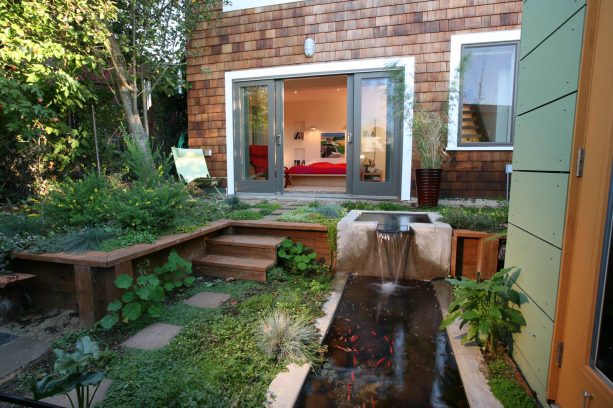
This is another wood retaining wall that is completed with a water feature.
The low retaining walls were constructed around the water fountain that leads to a koi pond in the middle of the landscape.
Actually, this landscape is a flat area. Yet, the landscaper wanted to create a multiple-level look, so the retaining walls are used to keep the soil stay in its place.
The medium tone wood retaining walls are equipped with tops. The tops can function as extra seating because it seems that there is no seating space in this area.
There are two wooden steps, attached to the retaining wall. The steps are useful to reach the upper level of this landscape.
The low wall is intentional. It is to create an even look at the concrete water feature in the middle.
The height of the wall and the water feature is the same, so both elements appear consistent and uniform.
12. Unfinished Wood Retaining Wall with Asymmetrical Ends

This is an ideal inspiration for a rustic landscape.
This mid-sized backyard features an upper and lower level. There is a staircase completed with a banister to access the upper level from the lower part.
Around the staircase, the soil needs to be stabilized. Thus, retaining walls are needed.
In order to create a whimsical and unusual look, the contractor created a retaining wall with asymmetrical ends. It is to make sure the trees and the bushes planted on the soil are more open and visible.
The multiple heights of the wall also give easy access for the homeowners to take care of their plants in the sloped area.
To maintain the rustic look, the wood for the retaining walls seems to be unfinished and untreated. Natural wood like this never fails to give a warm and natural look.
The wood type itself remains unknown, but it seems that it is cedar wood in its natural form.
13. Rustic Landscape with Wood Retaining Wall and Decorative Items
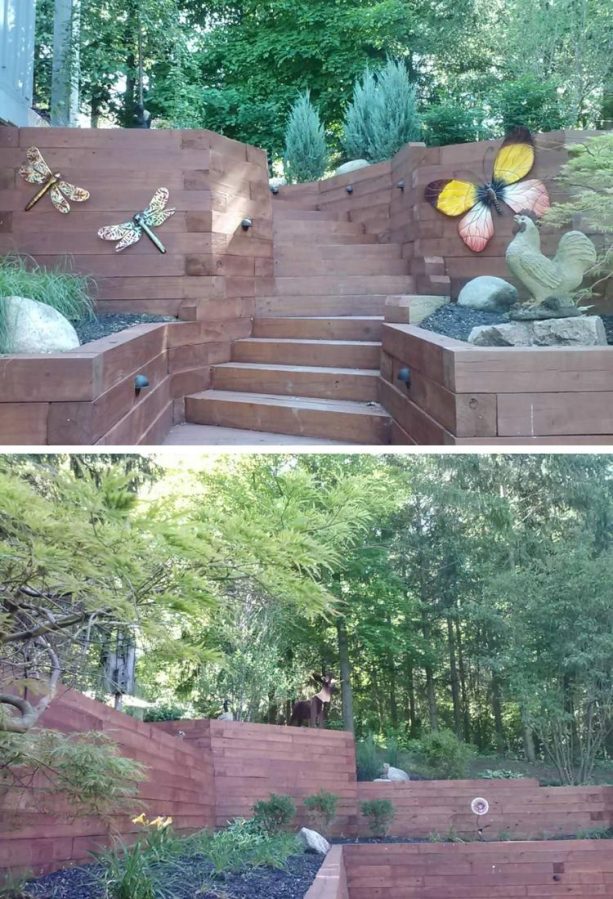
Another wood retaining wall with LED lights.
It is quite common now to complete retaining walls with lighting, especially if the retaining wall is located at the patio.
We can see here that there are multiple levels in this landscape. Thus, there is a staircase to reach the upper area easily.
The staircase is made of similar wood used for the retaining walls around. This way, a uniform look can be achieved.
Apart from the LED lights, these wood retaining walls are also accentuated with decorative items.
The huge yet pretty dragonflies and butterflies make the walls look more alive. This is an excellent way to decorate your walls. Retaining walls don’t have to be plain.
Sometimes, the texture of the material itself is not enough to give more character to your landscape. You need something like this to cheer up the entire yard.
The medium-tone wood works as a perfect canvas.
In order to create a similar look, make sure you polish the wood and finish it with the right stain, so the color won’t interfere with the decorative items. The texture of the wood walls should be sleek too, so it won’t be overwhelmed with too many decorations and characters.
14. Light Tone Wood Retaining Wall Completed with Stairs and Decks

If you prefer a traditional design over a modern look, you need to take a look at this picture.
This shows a traditional deck that is located lower than the main property. Actually, there are two decks here with a balcony style.
According to the landscaper, the decks and wood stairs already existed. So it was their job to build the retaining walls.
The landscape thought it would be better to create a consistent look instead of contrast, so they used a similar material for the walls to the staircase and the decks. It is because, in addition to being an affordable option, timbers are portable on a site where it is impossible to use the equipment.
The wood used here is in a light tone, and it seems that it is untreated. You can see the natural horizontal pattern on the wood clearly.
Untreated light tone wood like this is basically perfect for a rustic look. Yet, since the main property itself is in a traditional look, it gives a contrasting appearance to the house above.
The latticework that supports the decks here is useful to accentuate the entire light tone wood retaining walls. The latticework is meant to add a fun element to this landscape, lest it looks too boring.
How to Prevent Moisture Problems
We have seen the most beautiful wood majestic wood above. But, how to solve the moisture issue if you really want to use a wood wall?
If built with proper materials, completed with preservatives and waterproofing, a wood retaining wall can last for about 20 years or even more.
The main weakness may be the wood itself, which is prone to rot because of extensive wood-to-earth contact.
There is moisture in the earth that can improve lateral earth pressure. This can cause a short lifespan of wood walls.
In order to optimize the longevity of the wood wall, your contractor should pay close attention to water, where it pools and gathers both behind and on top of the wall.
The moisture accumulation can speed the decomposition of wood, so the structure of drainage is as important as the overall grades both at the top and bottom of the wall.
Despite the types of wood you’ve seen above, you should know that the best kind of wood for retaining walls is Douglas fir pressure treated combined with preservatives to avoid rot. It will be brown or green in color and rated for the earth to wood contact.
In many cases, a layer or waterproof sheeting should be applied to the backside of the wall to avoid direct contact with fill.
There should also be gravel packing behind the retaining wall, especially at the bottom where water pools during the rainy season.


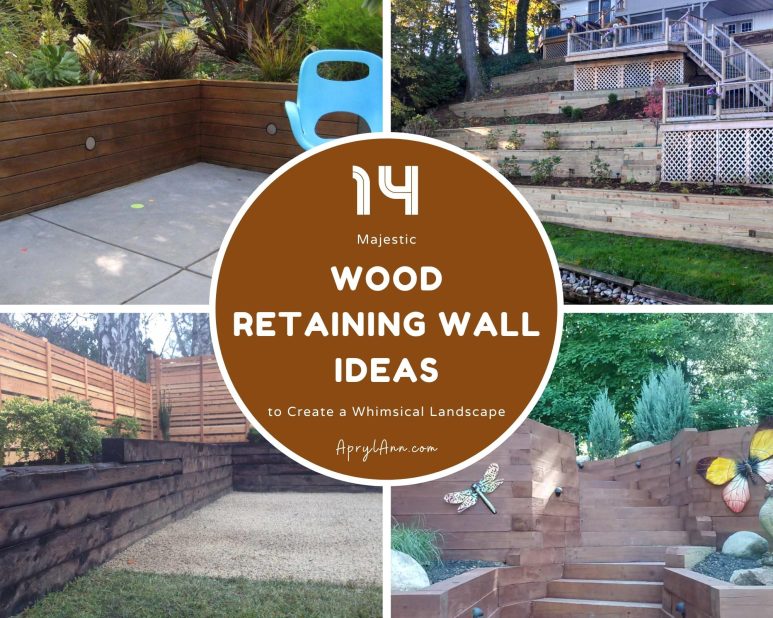
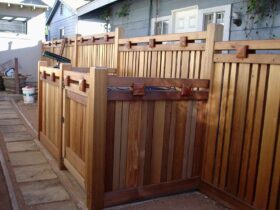
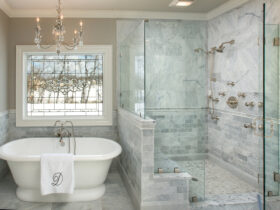
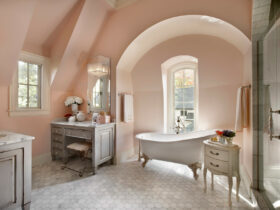
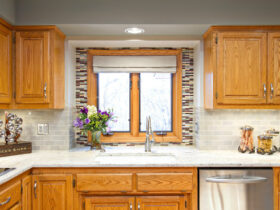
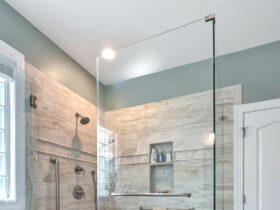
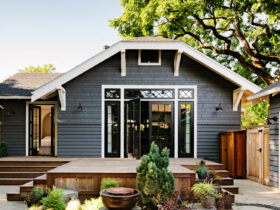
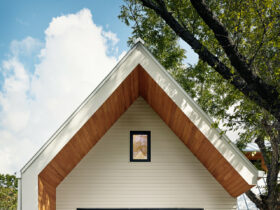
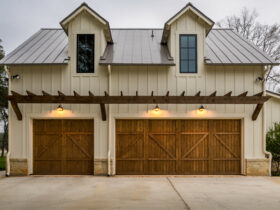
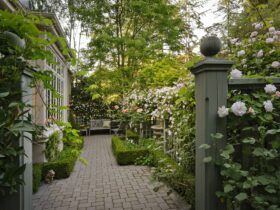
Leave a Reply
View Comments